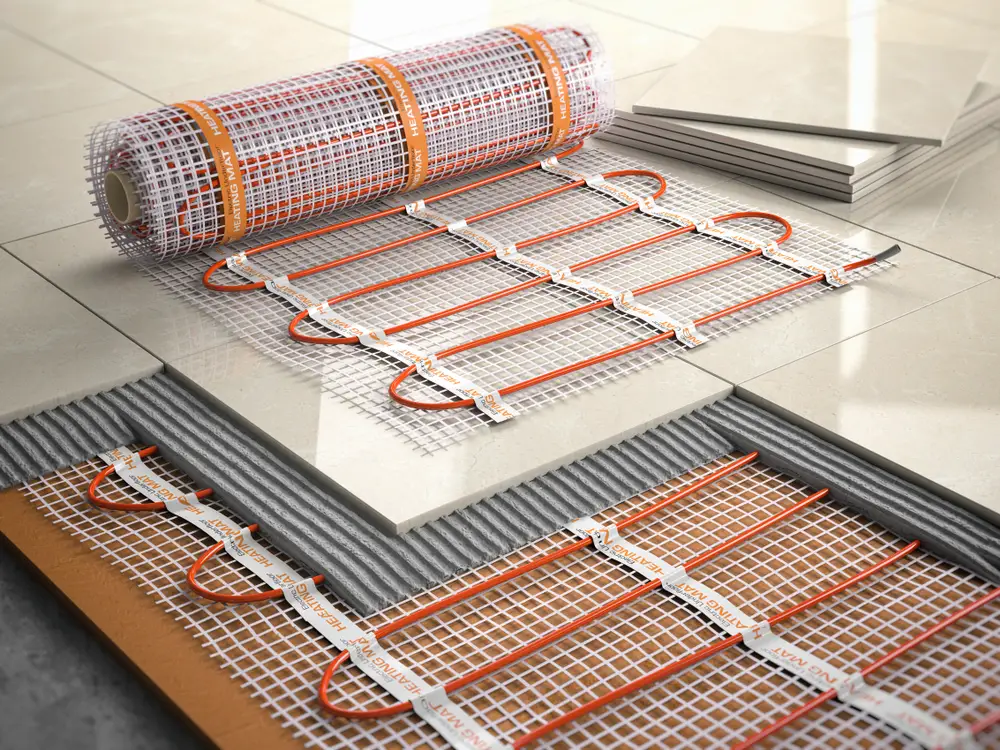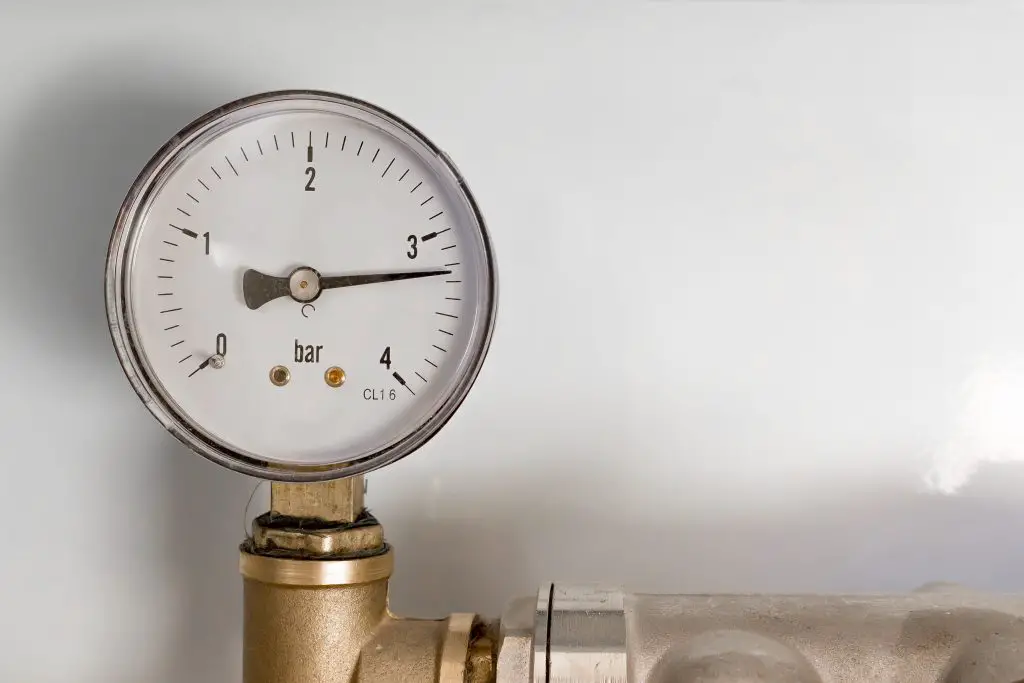Patchy Underfloor Heating is really frustrating! You’ve ripped out floors, replaced the cabinets, installed entire new room layouts, and now you’ve added fantastic underfloor heating. Or maybe you bought your dream house which happened to include underfloor heating. However, after a few months, you decide to use the system only to find that the heating is not consistent, with some patches of the floor being freezing while others are hot to the touch.
Electric underfloor heating can become patchy when specific system pads or cells dying due to damage, poor component quality or wear over time. Water-based underfloor heating systems can become patchy due to airlocks, pipe debris, electrical or wiring issues, and pressure problems.
Electric systems require that the pads be replaced while water-based systems should eventually equalize and become evenly heated.
It is important you have a professional set up your heating system manifold or assess it if you have problems. The positions of all valves and pins must be correct. You should always check the settings on your thermostat too.
Understanding how each system is affected by damage or just fast-moving water can be vital to preventing extreme heat from causing problems.
Many homeowners have to learn through trial and error what does and what does not work. This is why you will usually see people learning as much as possible about the underfloor heating systems in their homes before installing one or buying a home that has one.

What are the most common causes of patchy heating?
There are four causes of patchy heating in any home that you should know, with each one causing more problems than the last.
Usually, homeowners can fix some of the issues on their own, relying on the system being accessible when needing to be worked on.
Electric underfloor heating systems can be easier to fix and correct than water systems, while water systems can cost significantly less to fix if it is a small problem. Knowing why the heating is patchy is the most vital part of fixing it, without knowing the cause of a problem you cannot fix the symptoms.

Broken panels
Only occurring in electric underfloor heating, this problem is quite common with older systems as the panels become damaged with age and wear and tear. Electric systems are individual plates or cells that are spread throughout the home, with each cell responsible for heating its area of the floor. When these start breaking naturally the heating in the home becomes patchy and uneven.
While this can be quite a bothersome problem for those that may have just recently installed their underfloor heating systems, the good news is that it does not affect the heating of the house.
For a system to completely fail at heating your home then most or all of the panels would have to fail, which is extremely unlikely to happen.
Most homeowners continue to use their electric underfloor heating systems for a long time after the first few panels die.

Insulation mistakes
Underfloor heating needs to be insulated to work properly, either to keep cold air from the outside from coming in or to ensure that the heating from the panels or water system goes up into the home and not down into the ground.
Usually, patchy heating can be attributed to some parts of the system that has not been insulated properly, with a majority of homeowners not always realizing that this is the cause.
Many times, the insulation mistakes are minor and only found in places that were difficult to insulate, with most electric systems being automatically insulated.
Water systems are usually the ones that suffer from improper insulation as the pipes can often be placed in areas that cannot be insulated very well.
Air and Debris
Affecting only water-based systems, air can be the killer of these systems faster than most owners realize.
Every water-based system will have air stuck in the pipes somewhere that cannot escape and when this starts becoming too much of a problem the house will have patches that are not evenly heated. The pipes can also become blocked with debris – dirt or scale that has built up in the system.
Blockages like these prevent the water from getting to certain parts of the system, and the air does not transfer heat into the floor like water would, stopping the heat from rising into your home.
Water-based systems will have pressurized safety systems to ensure that as the water is heating up there is not so much pressure created from the heated water that pipes will burst.
Naturally, this means that some water and hot steam may escape when depressurizing. Usually, all that is needed to rectify this will be to add more water to the system, but a professional should be the one to look at this.

Too hot
Both systems can suffer from this, with electric systems not always able to be equally hot across the floor. Water systems can also get too hot if there is a significant difference in pressure across the system.
This creates patchy areas of heat throughout the house that will be equalized as the system continues to run. Usually, these patchy heating problems cannot be fixed with ease, as they are a natural part of the system’s operations.
Electric systems are usually all capable of reaching the same levels of heat when they have been newly installed, however, this fades with age.
The effectiveness and efficiency of underfloor heating systems will start to vary with age, with panels that are used a lot more usually delivering inconsistent heat. This is why you may find that even at max thermostat settings, cells that have more rarely been used can easily reach maximum temperatures quicker than those that are used often.
How can you make the entire floor heat up at once?
To have the entire home heated at the same time it is best to have the heating start low and then slowly increase the temperature to what you need. If you are having the system start at the max temperature that you need it to be, the water and electric panels have to be heated as fast as possible.
This creates an imbalance as colder parts need to actively work towards heating up and reaching operating temperatures. Usually, people will turn the system on to the max heat that they need causing the entire system to heat up rapidly and expecting each part of the system to reach the same high temperatures across the entire system.
However, lowering expectations is the best way to ensure that the system will be properly heated. Leaving the system to slowly reach the right temperatures will ensure that there are no patchy areas, usually only taking a few hours to ensure that the system is evenly heated. As the system reaches equilibrium the patchy areas will become hotter and reach the same temperatures as the surrounding floor.
Check out this excellent article from underfloorheatingtradesupplies.co.uk for a few more of the technical reasons that can cause patchy underfloor heating.

How long should it take for the entire home to reach the desired temperature?
It should take the system between 3 to 5 hours for the underfloor heating system to reach the desired temperature that you have, while the system slowly heats up. For your home to reach the desired temperature can be anything from 5 to 12 hours as the heating slowly drifts up and increases the ambient temperatures of your home.
This is part of the challenge that many homeowners that have underfloor heating face. Many homeowners avoid this problem by keeping the system on low settings for the entire winter, though this can ask more of the underfloor components and lead to quicker ageing of the system.
You can also use a smart thermostat to turn on the system in the early hours of the morning so that it is ready to go my morning.
As the system can take a long time to reach operating temperatures, as well as heating the ambient temperatures of a home, it can be a challenge to wait. This causes many people to turn the heating up too high for long periods, causing inconsistent heating, damage to internal systems, and sometimes even leaks for water-based systems.
Underfloor heating can be the perfect answer for those with allergies, while heating the entire house to the same temperature. This is why you need to learn to be patient, as the system heats the home and you can comfortably sit and enjoy the heat once everything has been allowed to do what they need to do.
Professional Underfloor Heating Assessment
Underflooring heating will be patchy at times, and if it becomes a problem that persists it may not be as serious as you initially thought. Patchy heating locations should only be worried about once large swathes of the ground do not heat up as desired, usually indicating that there is a major flaw in the system.
I recommend you ask a professional to assess your underfloor heating system if it is excessively patchy, it pays to attain a qualified assessment to find out exactly what’s wrong. That way you can work towards a fix more easily.
I hope you found this article helpful! Check out our related articles below. You may find our articles on Why my Underfloor heating is Noisy? and How do I know if my Underfloor heating is working? useful.
Lots more Underfloor Heating Information Here
- What Depth is Required for Underfloor Heating?
- Turning on Underfloor Heating for the First Time – How Long to Wait?
- Can you lay Vinyl flooring over underfloor heating?
- Do Tiles Crack With Underfloor Heating?
- Can You Heat a Whole House With Underfloor Heating?
- Can You Have Underfloor Heating Upstairs?
- Will Underfloor Heating Raise My Floor? – Underfloor Heating Layers Explained
- Can I put furniture on top of underfloor heating?
- How Do I Know If My Underfloor Heating is Leaking?
- Can You Combine Underfloor Heating With a Ground Source Heat Pump?
- Is Underfloor Heating Safe?
- Does Underfloor Heating Add Value to a Property?
- Can you have Wooden Floors with Underfloor Heating?
- Can Underfloor Heating Cause a Fire?
- What temperature should Underfloor Heating be set at?
- Can I Put a Rug Over Underfloor Heating?
- How Long Does it Take for Underfloor Heating to Warm Up?
- Why is my Underfloor Heating Noisy?
- Why is my Underfloor Heating Patchy?
- How do I know if My Underfloor Heating is Working? – Common Problems & Fixes
- What can go wrong with underfloor heating?
- Can you Combine Underfloor Heating with an Air Source Heat Pump?
- Do you keep underfloor heating on all the time?
- Does Underfloor Heating work with Smart Thermostats?
- Kitchen Underfloor Heating – Should Underfloor Heating go Under Kitchen Units?
- How much energy does Underfloor Heating use?
- Underfloor Heating in Summer and Winter
- Lifespan of Underfloor Heating
